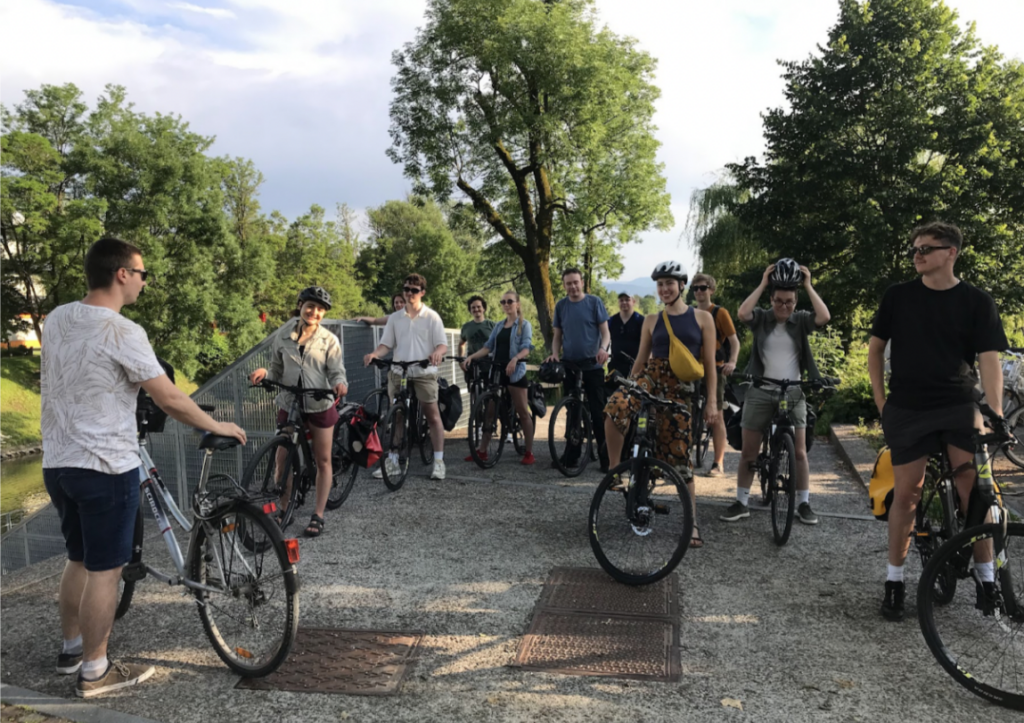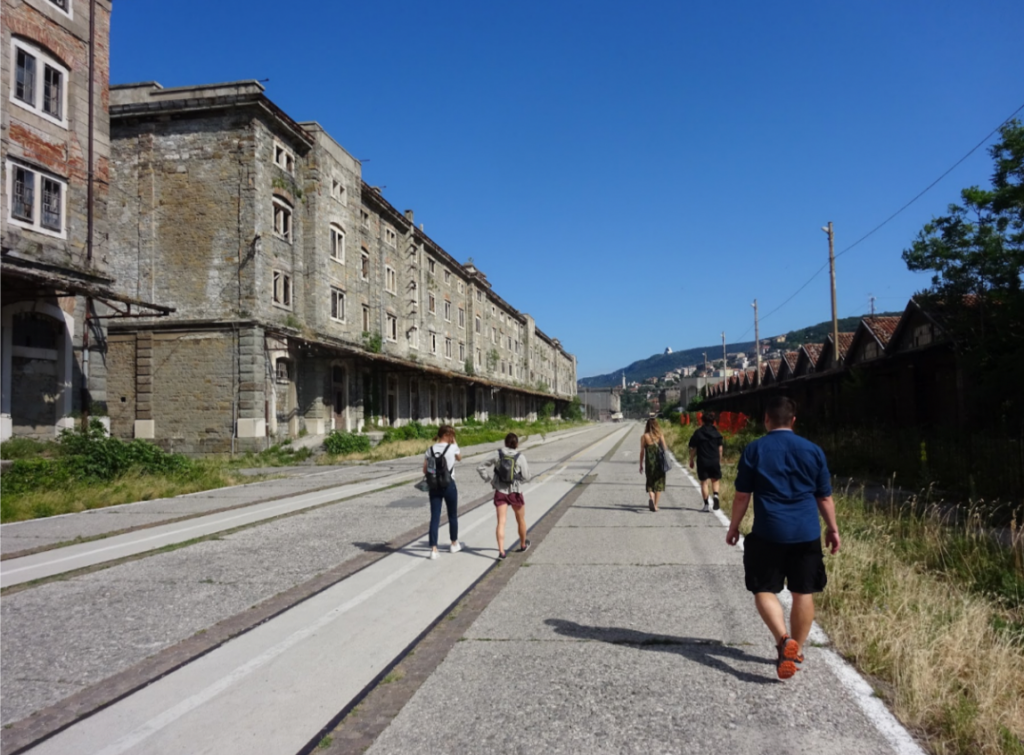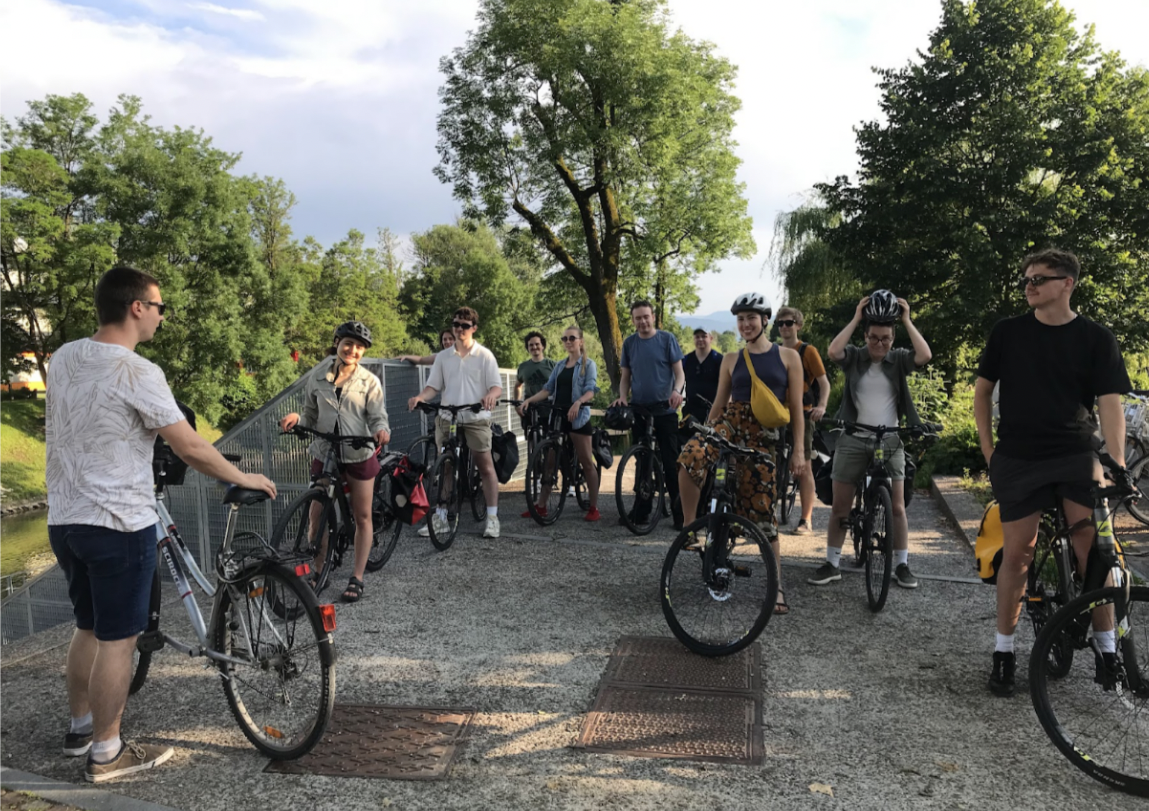By Benton Meador and Julie Plichon
After a three-year hiatus induced by Covid, the Young Urbanist cycle trip took place between 8-12 June, taking a group of 12 participants through a sensorial journey filled with chances to pique our urbanist ponderings, from the urban exemplar of Ljubljana, to the alpine allure of the Slovenian countryside, and to the sun-soaked coast of Trieste. The annual YU cycle trip focuses on inspirational places that promote active travel and sustainable cities. As we grapple here in the UK with what a Governmental ‘plan for motorists’ means for our cities, it was time to reflect on our recent European learnings.

Ljubljana, the grey city turned green
Home to 300,000 people, Ljubljana is the budding, small capital of a young country that emerged from the dissolution of Yugoslavia. Prior to the grand plans that began from 2007 to shape what we know as Ljubljana today, the city was colloquially referred to as the ‘grey city’. The chief planner, Ljiljana Jankovic, pointed out that the city had once been dominated by traffic. In order to manifest its sleeping beauty, the former mayor Zoran Jankovic devised a plan – ‘Vision 2025’ – to radically transform Ljubljana within the strictly defined ecological and natural constraints of its surroundings. Our urban cycle tour started at the Cukrana (an old sugar factory turned into a cultural and art space), on the riverbanks of Ljublijanica to a series of pedestrianised squares, accompanied by Janez Koželj, former vice mayor and urban designer who led the street design guide for the city, giving it its consistent identity through street furniture and materials.
‘No compromises if you want to dream big’ could be the city’s motto. With the courage to face and address the consequences of modern car-centric planning and design head-on, Ljubljana not only declared war on the car, but it also embodied an uncompromising force to reclaim the city as a place for people – one square at a time – removing car parking, pedestrianising streets, and developing an extensive network of cycle lanes that connect the city to its natural environment. The regeneration of public spaces for active travel was politically challenging: several experts we met quoted an initial 90% of the population against pedestrianisation – which flipped ten years later to 90% in support. The bus network had to be rationalised with the closure of some bus routes through the historic medieval centre to pedestrianise – a tough decision at the time, compensated by a more geographically extensive network, free accessible electric minibuses called Cavaliers, and the famous 1km long bus-only Slovenska Street shared space, designed by Dekleva Gregoric Architects. We met head architect Tina Gregoric who pointed out how the scheme incorporates new street trees, floating lighting to declutter the space as much as possible, and a Roman paving pattern, giving the street its unique identity. Of note, the street does not designate cycle space, instead inviting cyclists to use the bus lane, which is designed to reduce vehicle speeds.

Alongside physical cycling infrastructure, the municipality has a network of public bicycles which can be rented for only 3 euros a year. Because of this, Ljubljana can boast of a modal shift of 13% – akin to Strasbourg, the French city with the highest national mode share for cycling, well ahead of UK cities.
We headed south towards Trieste, witnessing signs of an inclusive cycling culture, with an all-ages cycling marathon taking place in the Slovenian countryside, and a slow and respectful driving culture which made the Slovenian leg of the cycle ride a pleasure. Picturesque and quaint alpine houses dotted the windswept grass fields as the group cycled through the mountainscape. It should be noted that the Eurovelo Route 9 between the two cities is currently under development, the group had to share the road with traffic, although most roads were local with little vehicular flow.
Trieste, an imperial port with an enviable opportunity at its core
On approach from Slovenia, Trieste can be seen standing guard over the Mediterranean, with vertiginous gradients and the impressive brutalist Rozzol Melara complex accompanying the mountainous descent. As the former main port of the Austro-Hungarian empire, Trieste has the grandeur of an imperial city, paralleled by the beauty of its Venetian architecture. Trieste’s planning has led to powerfully wide streets, which in the motor age have been transformed for fast-moving cars, paving the way for a stark difference in both risk and feel compared to our journey within and from Ljubljana.
On Sunday we paid a visit to Stradivarie Architects, whose office is housed in an impressive typical imperial building, where they offered us a generous breakfast whilst showcasing the numerous cycling plans they are developing for metropolitan areas throughout Italy. The plans span across several local authorities, which adds complexity to network development – a situation which reminded us of London’s administrative layering.
On Monday, we met town hall’s Monica Goina and Giulio Bernetti to discover the city’s old port, an expansive 20 million euros mixed-use opportunity site in the middle of the city. We learned that cable cars will be implemented from the port to the city’s northwest extents, carrying approximately 2,500 per day at maximum capacity after proposals for a new tramway were shelved. The decision against the tramway seemed based on a desire to not alter the existing road network.
Not only did the public transport offering seem to fall short of demand, but the city has limited on-street cycle parking, which creates a real barrier for future uptake.
The trip uncovered how road space reallocation makes wonders in Ljubljana whilst Trieste’s road network felt disproportionate for the size of the city. With its emerging Cycling plan, which can be a catalyst to see change on the streets, Trieste’s wide avenues currently dominated by cars offer ample and hopeful opportunities to introduce a human scale to the streetscape of Trieste.







